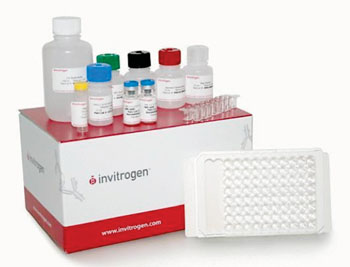Potential Biomarker Identified for Alzheimer's Disease
By LabMedica International staff writers
Posted on 18 Aug 2014
A genome-wide association study (GWAS) has been conducted on family-based cohorts using an approach that accounts for family structure and calculates a risk score for Alzheimer's Disease (AD) as the outcome.Posted on 18 Aug 2014
Links between the most promising gene candidate and AD pathogenesis were explored in silico as well as experimentally in cell-based models and in human brain to identify novel AD loci using a unique family-based approach that can detect robust associations with infrequent variants such as minor allele frequency.

Image: The Aβ42 human enzyme-linked immunosorbent assay (ELISA) Kit (Photo courtesy of Invitrogen).
Scientists at the Boston University School of Medicine (Boston, MA, USA) obtained data from the Framingham Heart Study cohort and then confirmed their finding in a larger dataset from the Alzheimer's Disease Genetics Consortium and other datasets. The team used many different techniques to obtain the required information including enzyme-linked immunosorbent assays (ELISA), sodium dodecyl sulfate–polyacrylamide gel electrophoresis and western blotting, primary neuron culture and tau immunofluorescence, and analyses of gene expression in the brain.
The ELISAs were carried out using the human Aβ40 and Aβ42 kits (Invitrogen; Carlsbad, CA, USA) and quantitative polymerase chain reactions (PCRs) were run on an ABI 7900HT real-time machine (Applied Biosystems; Foster City, CA, USA). The scientists found that variants in a new gene, Plexin A4 (PLXNA4), may increase the risk of developing Alzheimer's disease (AD). A form of the protein encoded by this gene promotes formation of neurofibrillary tangles consisting of decomposed tau protein, one of the two pathological hallmarks of the disease. There was strong evidence of an association with several single nucleotide polymorphisms in PLXNA4, a gene which had not been previously linked to AD.
Lindsay Farrer, PhD, the senior author of the study said, “We showed that PLXNA4 affects the processing of tau as it relates to neurofibrillary tangles, the primary marker of AD. Most drugs that have been developed or that are in development for treating AD are intended to reduce the toxic form of beta-amyloid, a sticky substance that accumulates in the brain of persons with AD, and none have been very effective. Only a few drugs have targeted the tau pathway.” The study was published on July 29, 2014, in the journal Annals of Neurology.
Related Links:
Boston University School of Medicine
Invitrogen
Applied Biosystems














